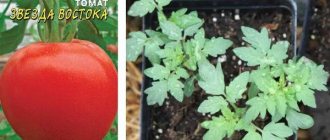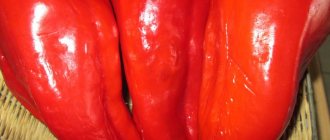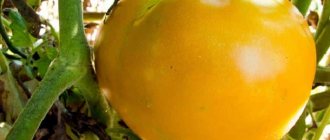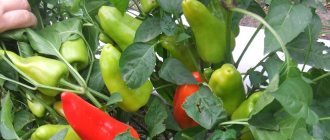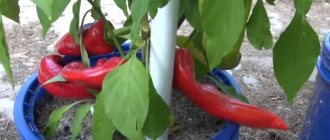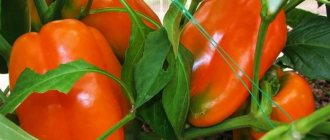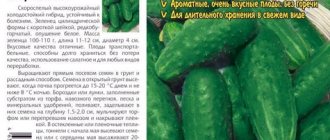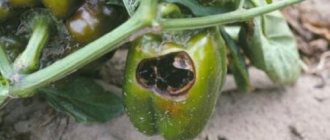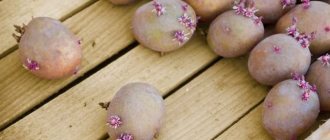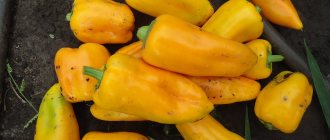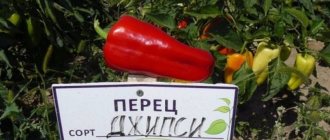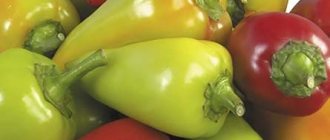Description and characteristics of the variety
The hybrid is classified as mid-season, medium-sized. The height of the bush is 90 cm, the ripening time of the fruit is 113–120 days from full germination. Peppers weighing up to 400 g are cube-shaped with a red glossy surface and medium-pronounced ribs that divide the pepper into 5 lobes. The fruits are located on the bush with the tip down. The thickness of the pulp is up to 1 cm. Peppers are suitable for freezing and preparing your favorite dishes.
Giant Red Star of the East is a hybrid pepper produced by the SeDek agricultural company. Unlike other “Stars”, it is not in the State Register. This does not mean that the hybrid is worse - it’s just that the culture was bred a little later.
Reviews of pepper Star of the East
If you grew this sweet pepper, please write whether you liked it or not. What was the yield under your climatic conditions? How do you rate the disease resistance of this hybrid? If possible, attach a photo of the entire bush or individual fruits you grew to your comment. Thank you!
Your feedback and additions to the description will help you evaluate this hybrid more objectively and decide whether to plant it or not.
Read also: Popular types and varieties of hawthorn: plum-leaved, decorative, varieties for the Moscow region
Landing
Seeds are sown in February.
Preparation:
- The seeds are immersed in water with salt (a tablespoon of sodium chloride per liter of water).
- The floating seeds are removed, those that have fallen to the bottom are taken out and washed in running water.
- Soak the seed in a wet cloth for 1–2 days.
Sow in wet soil. Each seed is grown in a separate pot. Sowing depth - 1 cm.
Seedlings are grown for 60 days, maintaining the temperature on the windowsill at least 20 degrees. As the soil dries out, water it. If the central heating radiators are working, the bushes are sprayed daily. Fertilizing with Agricola or other complex fertilizer for seedlings is useful.
Before planting in open ground, the leaves are sprayed with Epin to reduce the stress of the bushes.
Varieties of Eastern Star
The Eastern Star pepper in its traditional version has a rich dark red color of the fruit. But it is interesting that at the stage of technical maturity, the cube-shaped pepper fruits have a milky cream color, as they ripen they become creamy-reddish and, finally, at the stage of full biological ripening they turn dark red.
After all, the stage of biological ripening is necessary only for the complete maturation of seeds so that they can germinate well in the next season. But,
- firstly, the seeds can ripen well in peppers left to ripen indoors.
- secondly, in any case, it makes no sense to plant seeds from grown hybrids next year, since they will not repeat the properties of their parents. Therefore, it makes no sense to wait for biological maturation.
Read also: Felt cherry Alice variety description
And all the peppers in this series are distinguished by their amazing and variable coloring both at the stage of technical and biological maturation.
Purple
This hybrid does not have the highest yields (on average about 6-7 kg/sq. meter), but its fruits ripen relatively early and look very exotic. They turn dark purple at the stage of technical ripening, but at the stage of full maturity they become dark cherry. The walls of the peppers are average in thickness - 7 mm, the fruits are prism-shaped, weighing from 180 to 300 grams.
Chocolate
It is not for nothing that the Chocolate Star of the East pepper is mid-season in terms of ripening. Like many late varieties, it is characterized by high yield - up to 10 kg/sq. meters and fairly large fruit sizes - 270-350 grams. The color of the pepper fruits is also unique, but chocolate lovers will be disappointed - at the stage of full ripening, the peppers do not become completely chocolate, but rather dark red-brown. And during the period of technical maturity, the color of the fruit is dark green. In addition to its excellent taste, this hybrid has a distinctive peppery aroma.
Golden
This hybrid does not have particularly outstanding characteristics, except for the friendly ripening of fruits. Its yield is average - about 7.5 kg/sq. meters. The size of the fruit is also average - approximately 175-200 grams with a wall thickness of about 5-7 mm. Dark green, elastic, juicy fruits turn bright yellow when fully ripe.
Pepper White Star of the East becomes milky white only during the period of technical ripening. If you still leave it to ripen on the bush, the fruits will soon turn dark yellow. By the way, in this sense it is not much different from the hybrid White pepper in the yellow star of the east.
Only the White Star’s yield is slightly higher (up to 8 kg/sq. meter) and the wall thickness reaches 10 mm.
White in red
And in this variety of the Eastern Star, the cuboid-shaped fruits, after a period of white coloring, gradually turn red. Productivity, wall thickness and fruit size are at an average level.
This hybrid differs from the traditional one in the prism-shaped shape of the fruits, and also in the fact that at the stage of technical maturity the fruits are dark green. The Red Star of the East pepper is also characterized by a weak but distinctive pepper aroma.
Tangerine
One of the most interesting varieties of this series of peppers. Productivity can reach 8-9 kg/sq.m. meters. The fruits themselves cannot be called small either; they reach a mass of 250-290 grams. After going through a dark green hue, the peppers become a rich dark orange color when fully ripe. The fruits are particularly juicy with a wall thickness of 8-10 mm and a rich peppery aroma.
Yellow and Orange varieties of Eastern Star pepper differ from each other only in color at the stage of biological maturation, which coincides with the name of the variety. During the technical period of maturity, they are distinguished by a dark green color. Both hybrids are early ripening and have unlimited growth. Each bush can simultaneously ripen up to 15-20 fruits, weighing on average 160-180 grams. Although the weight of the largest peppers can reach 250 grams. These hybrids are most profitable to grow in heated greenhouses.
Gigantic
Among the peppers of the Eastern Star series, three varieties are known with medium ripening periods and fairly large fruits, weighing up to 400 grams - Giant, Giant Red and Giant Yellow. Moreover, the first two hybrids are practically no different from each other. The latter variety, as you might guess, has fully ripened fruits that are bright yellow. During the period of technical maturity, the fruits of all three hybrids have a dark green color. The bushes grow quite tall, up to one meter. And although the size of the peppers is quite significant, these hybrids are not particularly productive. On average, from 7 to 10 fruits ripen on one bush.
Growing and care
The hybrid is recommended for all areas of the country. In the south, the crop is grown outdoors. In regions north of Voronezh, peppers are planted under film covers: the hybrid there shows maximum yield. It’s even better to use a glass or polycarbonate greenhouse for peppers.
The planting pattern is 70 by 40 cm. When the plantings are dense, an outbreak of fungal diseases is possible.
Seedlings are planted without damaging the roots. The culture does not like deepening and acidic soil. Peat or fresh manure is not added to the soil.
Pepper develops normally if its young leaves are lighter than the old ones. If the old leaves have turned lighter, the plant does not have enough nitrogen. Fertilizing with urea will help: dilute a tablespoon of the product in 10 liters of water, spray the resulting mixture onto the leaves.
Vegetable peppers like to be fed with fermented manure or bird droppings:
- Pour 1 liter of mass into 10 liters of water.
- Leave for 5–7 days, stirring occasionally.
- Dilute with water (1:5) and water at the root.
Fertilizing with organic matter stops when the pepper begins to set fruit. Next, only mineral fertilizers are used in the form of solutions, pouring the product under the root.
Superphosphate is the most popular phosphate fertilizer, but it is difficult to dissolve. The product is applied even before planting the seedlings. The depth of placement of superphosphate is at least 10 cm, otherwise the additive will not be absorbed.
You cannot do without watering when growing peppers. The culture suffers from the slightest lack of moisture. You need to take hold of the watering can as soon as the top layer of soil dries out, without waiting for the leaves to lose turgor: at this stage, the pepper will begin to shed ovaries and flowers, causing the yield to decrease several times.
It is recommended to mulch the bed with peppers with mown grass (a layer at least 15 cm thick). This will help keep the soil moist and protect the roots from overheating in the sun.
Pepper Star of the East must be shaped and tied. Before the main stem forks, all the stepsons are removed. The two remaining main branches are tied separately. Side shoots will appear on each one, where large fruits will form. Without support, the branches will break off.
Sometimes not two, but three stems are formed in a fork. The third one can be left, but if you need particularly large fruits, you will have to remove the “extra” branch.
The buds and flowers that grow inside the bush are removed: you will get small, irregularly shaped peppers.
The harvest begins at the end of July and continues until the end of September. The fruits are harvested once a week, cutting off with a knife along with the stalk, in order to preserve the harvest longer. Peppercorns are stored well at a temperature of about +10.
For which regions is the variety suitable?
Since the Zvezda Vostoka pepper variety is a mid-season crop, it is ideal for growing in both southern and northern regions. The very name of the variety suggests that the plant perfectly adapts to the Russian climate.
However, depending on the conditions, the Eastern Star will manifest itself differently at different latitudes.
Attention! In the northern regions, agronomists advise starting harvesting when the fruits acquire a creamy-orange hue.
It is recommended to grow the crop using seedlings
Diseases and pests
If you create the necessary conditions for pepper, then it will not get sick, since it has good resistance to diseases. Otherwise, the plant may be affected by:
- Apical rot . It can be recognized by watery spotting on the fruit. For control, 0.3% potassium chloride is used.
- Lythracnose . Brown spots form on the roots, and the vegetables become covered with watery spots and then fall off. Treatment with a 1% solution of Bordeaux mixture will help save the culture.
- Black leg . Dark brown spots appear on the leaf blade and fruits. You need to spray the bushes with a solution of Bordeaux mixture.
Among the pests dangerous to the Star of the East are:
- Spider mite . It takes the juice from the leaf blade, causing it to curl and dry out. To combat insects, use Karbofos solution. 1 liter of the drug is consumed per 10 m2.
- Slugs . They feed on leaves and leave a silvery coating on them. The drug Strela is suitable for the fight.
- Aphid . Because of these insects, flowers change their shape and fall off. To combat the pest, insecticides are needed: Karbofos, Keltan.
